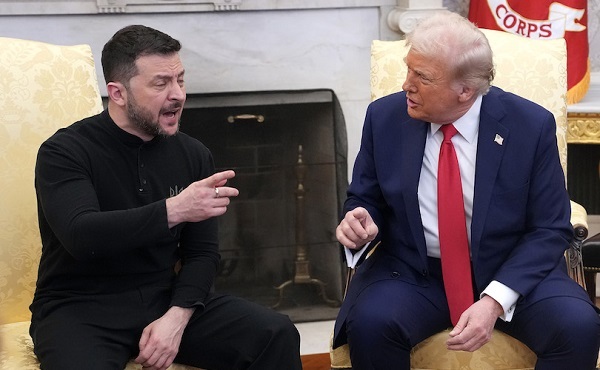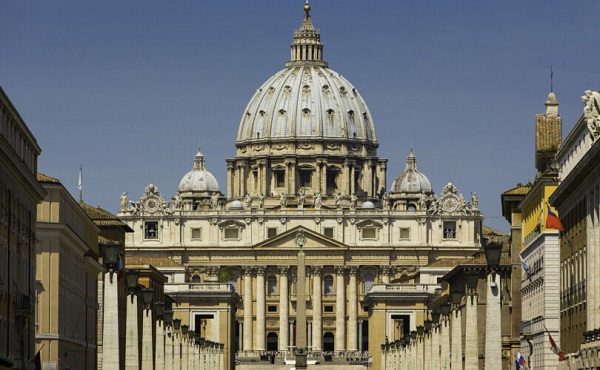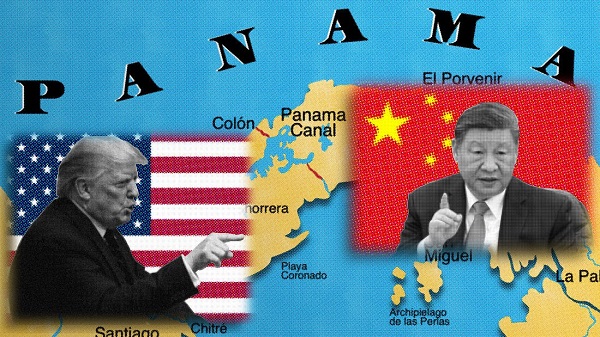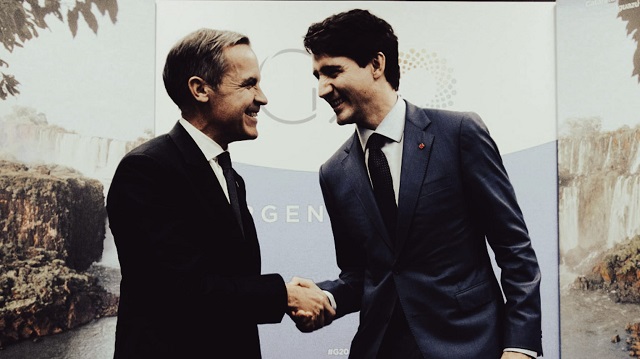International
Commerce Secretary on Oval Office debacle: Zelensky flies to Washington to sign deal then scuttles it

From LifeSiteNews
U.S. Commerce Secretary Howard Lutnick gave a brutally honest take on the clash between President Donald Trump and Ukrainian President Volodymyr Zelensky in the Oval Office this past Friday, calling him a ‘troublemaker,’ not a ‘peacemaker.’
We’ve watched a lot of different takes on the explosive Friday oval office meeting between Volodymyr Zelensky and President Trump, however this explanation from Commerce Secretary Howard Lutnick is exceptional.
Secretary Lutnick explains what the administration team anticipated from Zelensky versus what took place. Knowing the context of the congressional team that met with Zelensky prior to the Oval Office meeting, the explanation from Lutnick takes on even more sunlight. This is a very brutally honest take from a great member of the Trump administration. Watch:
President Trump’s repeated position that Zelensky is refusing to discuss peace because the U.S. is standing close with him, is exactly the reason President Trump is now going to create distance.
CUT HIM OFF – President Trump is going to force Ukraine to stand without U.S. support, only supported by the EU and U.K. It’s essentially a peacekeeping standoff. President Trump wants peace, the Ukrainian people want peace, Zelensky and the EU/U.K. are willing to fight Russia to the last Ukrainian.
It’s not about sending U.S. military goods into Ukraine, the Trump play can be twofold. (1) We stop paying for their government operations; and (2) potentially we turn off the U.S. satellite targeting systems that Ukraine is using. Then watch what happens.
International
Conclave to elect new pope will start on May 7

From LifeSiteNews
By Michael Haynes, Snr. Vatican Correspondent
The conclave will see cardinals gather in the Sistine Chapel to elect a new pope as the 267th Roman Pontiff.
The Vatican has confirmed that the new conclave will start on May 7, as cardinals look to elect the new pope following Francis’ death.
After the close of the General Congregation this morning, the Holy See Press Office confirmed to journalists that the conclave will commence on May 7, next Wednesday. This falls in the time scale set by the Church’s law, which mandates the conclave start between 15 and 20 days following the death of a pope.
Pope Francis died on April 21, a week ago today.
His funeral was held on Saturday, as cardinals have continued to grow in number at the Vatican as they return to the City State from across the world.
May 7 will see the cardinals gather for a Mass in the morning, as they pray for guidance for the forthcoming conclave and celebrate the specific Mass for the election of a new pope. They will then process into the Sistine Chapel for the first round of voting to be held in the afternoon.
Some 180 cardinals were present for the General Congregation today, with over 100 cardinal electors present out of that number. They will continue to meet in General Congregation prior to the Conclave, upon which time they will be sequestered in the Vatican and isolated from the outside world in order to preserve the integrity of the conclave.
Readers can find LifeSite’s full explainer on the process here.
There are currently over 130 cardinal electors in the College of Cardinals, and it is these cardinals only who will form part of the voting members in the Sistine Chapel.
Prior to that date, though, the cardinal electors can make use of the presence of those cardinals aged over 80 at the General Congregations, who will impart their wisdom and advice to the younger members of the college.
Business
Trump demands free passage for American ships through Panama, Suez

 MxM News
MxM News
Quick Hit:
President Donald Trump is pushing for U.S. ships to transit the Panama and Suez canals without paying tolls, arguing the waterways would not exist without America.
Key Details:
-
In a Saturday Truth Social post, Trump said, “American Ships, both Military and Commercial, should be allowed to travel, free of charge, through the Panama and Suez Canals! Those Canals would not exist without the United States of America.”
-
Trump directed Secretary of State Marco Rubio to “immediately take care of, and memorialize” the issue, signaling a potential new diplomatic initiative with Panama and Egypt.
-
The Panama Canal generated about $3.3 billion in toll revenue in fiscal 2023, while the Suez Canal posted a record $9.4 billion. U.S. vessels account for roughly 70% of Panama Canal traffic, according to government figures.
Diving Deeper:
President Donald Trump is pressing for American ships to receive free passage through two of the world’s most critical shipping lanes—the Panama and Suez canals—a move he argues would recognize the United States’ historic role in making both waterways possible. In a post shared Saturday on Truth Social, Trump wrote, “American Ships, both Military and Commercial, should be allowed to travel, free of charge, through the Panama and Suez Canals! Those Canals would not exist without the United States of America.”
— Rapid Response 47 (@RapidResponse47) April 26, 2025
Trump added that he has instructed Secretary of State Marco Rubio to “immediately take care of, and memorialize” the situation. His comments, first reported by FactSet, come as U.S. companies face rising shipping costs, with tolls for major vessels ranging from $200,000 to over $500,000 per Panama Canal crossing, based on canal authority schedules.
The Suez Canal, operated by Egypt, reportedly saw record revenues of $9.4 billion in 2023, largely driven by American and European shipping amid ongoing Red Sea instability. After a surge in attacks by Houthi militants on commercial ships earlier this year, Trump authorized a sustained military campaign targeting missile and drone sites in northern Yemen. The Pentagon said the strikes were part of an effort to “permanently restore freedom of navigation” for global shipping near the Suez Canal.
Trump has framed the military operations as part of a broader strategy to counter Iranian-backed destabilization efforts across the Middle East.
Meanwhile, in Central America, Trump’s administration is working to counter Chinese influence near the Panama Canal. On April 9th, Defense Secretary Pete Hegseth announced an expanded partnership with Panama to bolster canal security, including a memorandum of understanding allowing U.S. warships and support vessels to move “first and free” through the canal. “The Panama Canal is key terrain that must be secured by Panama, with America, and not China,” Hegseth emphasized during a press conference in Panama City.
American commercial shipping has long depended on the canal, which reduces the shipping route between the U.S. East Coast and Asia by nearly 8,000 miles. About 40% of all U.S. container traffic uses the Panama Canal annually, according to the U.S. Maritime Administration.
The United States originally constructed and controlled the Panama Canal following a monumental effort championed by President Theodore Roosevelt in the early 20th century. After backing Panama’s independence from Colombia in 1903, the U.S. secured the rights to build and operate the canal, which opened in 1914. Although U.S. control ended in 1999 under the Torrijos-Carter Treaties, the canal remains vital to U.S. trade.
-

 2025 Federal Election22 hours ago
2025 Federal Election22 hours agoNine Dead After SUV Plows Into Vancouver Festival Crowd, Raising Election-Eve Concerns Over Public Safety
-

 2025 Federal Election20 hours ago
2025 Federal Election20 hours agoMark Carney: Our Number-One Alberta Separatist
-

 Opinion2 days ago
Opinion2 days agoCanadians Must Turn Out in Historic Numbers—Following Taiwan’s Example to Defeat PRC Election Interference
-

 International2 days ago
International2 days agoHistory in the making? Trump, Zelensky hold meeting about Ukraine war in Vatican ahead of Francis’ funeral
-

 C2C Journal2 days ago
C2C Journal2 days ago“Freedom of Expression Should Win Every Time”: In Conversation with Freedom Convoy Trial Lawyer Lawrence Greenspon
-

 International24 hours ago
International24 hours agoJeffrey Epstein accuser Virginia Giuffre reportedly dies by suicide
-

 2025 Federal Election23 hours ago
2025 Federal Election23 hours agoColumnist warns Carney Liberals will consider a home equity tax on primary residences
-

 2025 Federal Election12 hours ago
2025 Federal Election12 hours agoCanada is squandering the greatest oil opportunity on Earth
